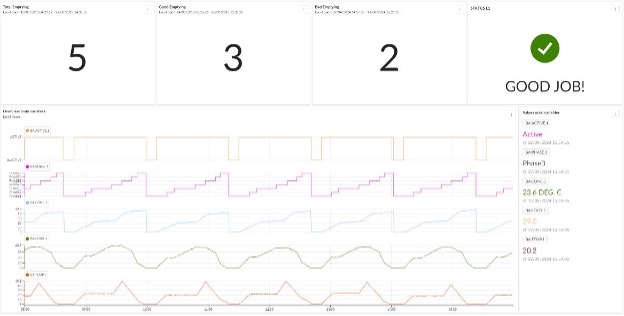

The Challenge
During product changeovers, the chocolate tank empties, slightly lowering the dosage. This can lead to low-weight products and customer complaints. Operators must manually increase rotor speed, but it's hard to verify if they do it.
The Goal
- Detect emptying events >15 min
- Verify rotor speed adjustments
- Enable traceability
- Support daily ops with a dashboard
The Approach
- The team applied Aggregations in TrendMiner to capture process dynamics, calculating rotor range and maximum tank levels over 20-minute moving windows. This provided a clearer view of how emptying unfolded beyond raw signal noise.
- Using Value Based Searches the system automatically detected good and bad emptying periods of at least 15 minutes by combining level conditions (max > 60 & current < 50) with rotor activity (range > 0 / range = 0).
- With Event Contextualization in TrendMiner, these periods were labeled as successful or failed emptying events and directly compared across historical signals, highlighting differences in operating conditions.
- A dedicated Dashboard then brought everything together—event counters, historical trends, and real-time tiles of key variables—into a single monitoring view.
Insight: With these TM features, you gain a clear, contextualized view of operator actions during emptying, improving quality control and operational efficiency.

The Results
The Takeaway
Real-time monitoring improved traceability, reduced complaints, and ensured consistent dosing during critical periods.
The Challenge
During product changeovers, the chocolate tank empties, slightly lowering the dosage. This can lead to low-weight products and customer complaints. Operators must manually increase rotor speed, but it's hard to verify if they do it.
The Goal
- Detect emptying events >15 min
- Verify rotor speed adjustments
- Enable traceability
- Support daily ops with a dashboard
The Approach
- The team applied Aggregations in TrendMiner to capture process dynamics, calculating rotor range and maximum tank levels over 20-minute moving windows. This provided a clearer view of how emptying unfolded beyond raw signal noise.
- Using Value Based Searches the system automatically detected good and bad emptying periods of at least 15 minutes by combining level conditions (max > 60 & current < 50) with rotor activity (range > 0 / range = 0).
- With Event Contextualization in TrendMiner, these periods were labeled as successful or failed emptying events and directly compared across historical signals, highlighting differences in operating conditions.
- A dedicated Dashboard then brought everything together—event counters, historical trends, and real-time tiles of key variables—into a single monitoring view.
Insight: With these TM features, you gain a clear, contextualized view of operator actions during emptying, improving quality control and operational efficiency.

The Results
The Takeaway
Real-time monitoring improved traceability, reduced complaints, and ensured consistent dosing during critical periods.
Access now
Subscribe to our newsletter
Stay up to date with our latest news and updates.
Other Webinars on Demand
Press Play on Operational Improvement
Other Resources
Explore Our Newest Content to Maximize Your Operational Efficiency





.jpg)





